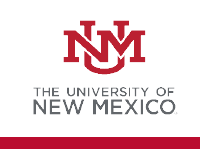-

A Comparison of Two Different Methods of Bayonet Fighting
Armond Harold Seidler
The study is an attempt to analyze and compare two methods of bayonet fighting, the United States Army Method (Method A) and the Experimental Method devised by the author (Method B), by use of three separate but related research techniques: Cinematographical Analysis, Energy Output Analysis and Group Competition.
-

Climbing a Rainbow: A Family Journey of Discovery
Calvin Horn
A regent at the University of New Mexico, Calvin Horn, describes a summer his family spent in the Pecos Wilderness, a nature preserve in Rociada, New Mexico. It speaks about his personal journey of discovery and the ways his family grew through their experiences.
-

Elizabeth P. Simpson: Menu for Success
Betty Huning Hinton
This biography of Elizabeth Parkinson Simpson was written because of her accomplishments in a generation that coincides with the development of the University of New Mexico. She was Chairperson of the Home Economics Department at the University of New Mexico from 1918 until 1952 when she retired.
Her imprint on the young women who were trained in her Home Economics Department will never be forgotten, nor will her contributions to the growth of the state of New Mexico. Teachers trained in her field returned to their homes throughout the state to pass on that training to others.
-

New Mexico's Troubled Years
Calvin Horn
Foreword
The history of New Mexico is a distillation of the American experience. It provides striking evidence of the truth of Walt Whitman's dictum: "Here is not merely a nation but a teeming Nation of nations." For New Mexico offers a compact illustration of the way a diversity of races and cultures pooled their traditions and skills to build an American state—and, in doing so, displayed impressive qualities of courage and resourcefulness.
New Mexico's history goes back many centuries to the time when the Pueblo Indians, confronted by drought, disease and hostile tribes, developed a civilization only a little less advanced than those of the Aztec and the Maya to the south. Then the conquistadores of Spain, laboring valiantly across trackless plains, wove a new strand into the New Mexican fabric. Mexicans and Yankees soon made their distinctive contributions. Today New Mexico stands as an example of the ability of people of diverse backgrounds to live and work together in amity.
This volume tells the story of New Mexico's first years within the United States. These were stirring and picturesque times, but they were also times of uncertainty and peril. The early governors faced hard problems in establishing law, justice and a stable framework of society on a tough and undisciplined frontier. Acting without precedent, under conditions that required immediate decision, they had to impro vise, trying to bring calm out of chaos, equity out of vigilantism. With the advantage of hindsight, we can discover many instances where they might have acted more wisely. Nevertheless, they deserve to have their trials and their accomplishments preserved in the record of our nation's history.
In these formative years, New Mexico was dependent on the national government for almost total support. We can be proud that the investment of the people of the United States in New Mexico is today paying dividends to free people everywhere. The largest known deposits of uranium in the world are in New Mexico, along with important reserves of oil, copper and timber. The state is celebrated for its atomic and space research facilities. Yet the scenic grandeur on every hand forever reminds us of New Mexico's foundations in the past. Not the least of New Mexico's resources is the quiet spectacle of yesterday dwelling in harmony with tomorrow—spectacle which offers the hope of a brighter future for men and women all over the world.
-John F. Kennedy
The White House
July 1963
-

Soledad Chávez Chacón: A New Mexico Political Pioneer, 1890-1936
Dan D. Chávez
This is a study of Soledad Chávez Chacón, a New Mexico political pioneer: she was the first Hispana to be elected to a state office, namely, the office of secretary of state; the first woman to preside as NM governor (as acting governor); and the first Hispana NM state legislator from Bernalillo County.
-

Space Programming for College of Education Building
Flatow, Moore, Bryan and Fairburn
This report is intended as a working tool for those involved in planning and is at this stage yet unfinished and still being refined. It will stay in this form, somewhat, until the building is occupied. It is reproduced at this time to show the direction of our efforts and to encourage constructive criticism and suggestions on everything except spelling, grammar and form.
-

The College of Arts and Sciences: A Centennial History: 1889-1990
UNM College of Arts and Sciences
Table of Contents
A History of the College of Arts and Sciences by William M. Dabney
American Studies at the University of New Mexico: A Centennial History, 1944-1989 by Susan J. Kilgore
Anthropology at UNM, 1928-1968: A Trial Formulation by Philip K. Bock
History of the Biology Department by Donald Duszynski
A Short History of the Department of Chemistry by William M. Litchman
A Brief History of the Department of Communication by Richard J. Jensen
The Department of Communicative Disorders: 1947-1989 by Richard B. Hood
The Department of Economics: 1889-1989 by David Hamilton
The Department of English, 1889-1989: A Record of Service and Achievement by Robert E. Fleming
Geographic Studies at UNM by Robert D. Campbell
A Brief History of the Department of Geology by Barry S. Kues
A History of the Department of History by William M. Dabney
A Brief History of Journalism by Robert H. Lawrence
Linguistics at the University of New Mexico, 1889-1989: A Brief History by Garland D. Bills
A Brief History of the Institute of Meteoritics by G. Jeffrey Taylor
The Department of Modern & Classical Languages: A Comprehensive History by Dick Gerdes
The Philosophy Department at UNM by Hubert G. Alexander
A History of the Department of Physics and Astronomy from 1892-1989 by John R. Green, with recent amendments by Daniel Finley
Political Science at UNM by Fae L. Korsmo and Gilbert St. Clair
A History of the Psychology Department at the University of New Mexico, 1897-1986 by Cheryl J. Foote
History of the Department of Sociology by Charles E. Woodhouse
-

The University in Turmoil: Crisis Decades at the University of New Mexico
Calvin Horn
Excerpt of the Preface
Presented in this book is a regent's view of both the dramatic events and the daily operations of the University of New Mexico from 1960 to 1981. l chose these two themes—dramatic events and daily operations—to give a total picture of the University. These themes reveal both the turmoil and the tranquility of the University and, in turn, enable several important issues to emerge.
First, during a period of turmoil it is most important that the principles of a university be understood in order that reason prevail. During the Sixties and Seventies, the University on various occasions became embroiled in controversy both on and off campus. Each time this happened it was a result of failure of the people involved with the University to under stand its purpose, in particular the need to respect academic freedom.
The second theme is that the countless acts of its daily operation set the tone for how effective the University is as an institution of higher learning. How the University deals with people and their problems has never received the serious attention the question deserves. It is a myth that the University is a place of quiet reflection detached from society's troubles. Its 22,000 students, 1,150 faculty members, and a staff of 4,000 make the University a microcosm of the conflicting expectations and aspirations within our society. Meshing all these divergent aims is perhaps more difficult in a university than in almost any other organization because of the primacy given to academic freedom.
-

UNM's First Dean of Women: Lena C. Clauve
Betty Huning Hinton
This biography of Lena C. Clauve (pronounced "clove" as in the spice) was initiated as a segment of a project suggested by Betty Kelley, a close personal friend and colleague at APS, who is interested in history and research of all types. The initial idea was to interview retired women who had been in the work world during a time when most women stayed in the home, raising children. The project was designed to research the reasons for their working outside the home, and the influences in their lives that brought it about.
-

Works Progress Administration, State of New Mexico, Report of Work Conferences for Teachers and Leaders in Literacy Education and Recreation
Mamie Meadors
The findings of the Conference Committee, composed of teachers who work in CCC Camps, in villages, and in cities, is given in full as reported by them. We have, however, enlarged upon those findings and give more in detail some of the pertinent and practical developments at the conference.
UNM historical documents.
Printing is not supported at the primary Gallery Thumbnail page. Please first navigate to a specific Image before printing.


